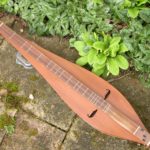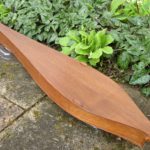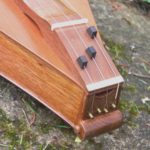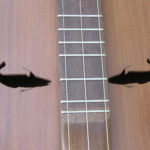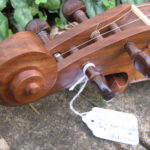Bear Meadow Dulcimers
Bear Meadow dulcimers are the creation of one dedicated luthier, Dwain Wilder from New York State. They are examples of individual care and craftsmanship, made one at a time in very small numbers. The attention to detail extends to the inscription inside – most have a short poem, specific to the instrument, its design and/or its original owner. So they are rare and expensive. The background story is explained below.
Walter Martin, creator of the iconic Sunhearth dulcimer, had taken the dulcimer to new heights with his beautiful designs and precise attention to detail. As his 80th birthday – and his 1000th instrument – beckoned, he thought of retirement. An old friend of the Martins’, Dwain Wilder, heard that Walt was preparing to retire and instantly decided he wanted to carry on the business. Dwain had been building very intricate ship models for twenty years, and had been kicking around the Sunhearth shop all that time, talking physics, metaphysics, astrophysics, string dynamics, and politics. Walt called him his “Number Two Son”, and it would be like keeping the business in the family if Dwain took it up.
Dwain Wilder studied formally with Walt for a few weeks to catch up on the arcane little corners of what Walt knew. He and Walt mulled over the possibility of Dwain getting the Sunhearth name. But Sunhearth is so rooted with the Martin family, the name of their home–it seemed best to leave the name with them.
So Dwain founded Bear Meadow Folk Instruments, a name that reflects his bear-like good humor, as well as his fondness for the power and dignity of the black bears now returning in the mountains of New York and Pennsylvania. He is dedicated to carrying on the reputation of Sunhearth, but he has also expanded on Walter’s craftsmanship. After a few years of development, Bear Meadow dulcimers have greater dynamic range and are more responsive than Walter’s were. And there are the new Concert Series models, the Concert Grand Hourglass, and the Baby Grand Teardrop, and the Swan, along with the Concert Hourglass (the original Lorraine Lee Sunhearth model) and the Concert Teardrop.
Article from 2003: “Dwain Wilder gently handles an unfinished dulcimer and tries to explain his passion for building them. “Our world is full of a kind of perfection that has no soul,” he says. “It’s mechanical. It can be beautiful… look at these cars pouring off assembly lines. But they don’t win your heart in the end.” Building dulcimers has clearly won Wilder’s heart. “It’s such a gentle instrument… there’s just a sweetness associated with it,” he says. In fact, dulcimer means “sweet music.”
Wilder, one of five or six full-time dulcimer builders in the US, tailors each instrument to his clients’ needs. “I pay attention to what and how they play,” he says. “Then I build something specific for them.” Many things affect the dulcimer’s sound, including the type of wood used. “Spruce has a brash sound,” says Wilder. “Redwood is sweet. If you think of Spruce as a nice, tart apple, Redwood is dark chocolate.”
With so few builders, you might expect the financial rewards to be great. They’re not. “I make a financial sacrifice to do this,” he says. “From time to time I have to get a real job to support my building habit.” That “real job” is computer programming. Another drawback is the time it takes to build one. Wilder estimates he makes about 11 dulcimers a year for musicians ranging from folk to jazz to blues. He believes it’s worth the sacrifice and time.
“When I go to festivals, I take along a carving project and people stop by to watch,” he says. “Many come back and say, ‘It’s wonderful to see someone doing this.’ They want to see the touch of the human hand… human perfection, not mechanical perfection. It draws people in and it draws me in, too.”
As he speaks about his work, it’s obvious that dulcimer building has brought Wilder something that can’t be measured in dollars; call it peace, call it contentment. “You don’t have to build dulcimers to find what I’ve found,” he says. “Others have found it elsewhere.”
2.220 2006 Bear Meadow Standard Teardrop #1145 £Sold inc. original custom Blue Heron case.
Date, details and original poem/inscription handwritten directly onto the inside back, using ruled pencil lines to guide writing: “Bear Meadow/ No. 1145 5-11-06/ Dwain Wilder/ Known by tugs on nets and lines/ In the depths of sea and lake/ Live the others moving/ Beyond shadow”.
Classic teardrop shape with walnut body, bookmatched on the back, hand-carved classic scroll, scroll foot and tail, and three lozenge-shape feet. Finely grained redwood top with fish soundholes (“The teardrop with the fish is actually taken from a photo of a hake, made for a commercial fisher,” email 18/02/2020) and extending over the sides (as does the back) in so-called “fiddle edges”. The closed pegbox, with flared ends, is fitted with Caspari geared pegs – they look almost exactly like normal brown wooden friction pegs but have internal gearing. Adjustment to stiffen or release the action is by a fine screw on the buttons. The pegbox is also de-coupled from the fingerboard and nut, with a small gap. Single piece walnut arched fingerboard with a shallow strum hollow and Sunhearth-type sloping tail end, on which are mounted small fine bead tuners, made from ebony. Bone two-piece nut and simple bone bridge (now with slightly raised action). Chunky brass string anchors and bone strainer, inset on top of tail. Sound port under fingerboard and venting to tail. Overall length 37”, lower bout 6⅝”, depth 2”, FBW 1½”, VSL 27⅝” (medium scale), weight 1lb 15oz (894g), strings 11, 14, 23w (Wilder recommends 12, 14, 22w. 6+ and 13+ frets.
Very responsive with a strong voice, good bass to treble balance and good intonation. Ideal for fingerpicking, but works equally well with delicate plectrum control. List price about $800. Comes with $200 luxury soft case. A beautiful piece of craftsmanship which produces a special sound.
Click on images below to enlarge.

